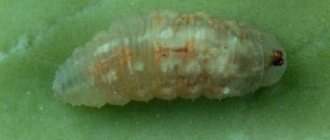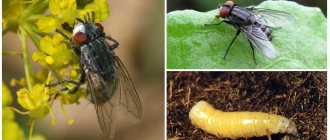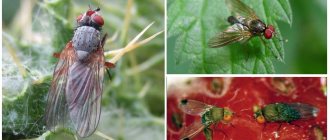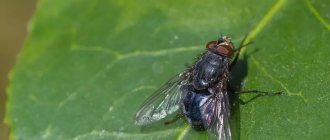Morphological description of the species
The tenacious beeweed, the common milkweed (Eristalis tenax) belongs to the hoverfly family (syrphidae), the genus of the beeweed. The adult body length is 14-16 mm. The head is rounded, most of it is occupied by the eyes located on the sides. Face with a wide black stripe. The eyes are equipped with vertical stripes of dense hairs. Arista is naked, her antennae are short and black.
Information. The external resemblance of the common milkweed to a bee serves as protection from enemies. Birds do not notice the absence of a second pair of wings and short antennae.
The chest is brown, covered with dense grayish-brown hairs. The wings are transparent, and when they hover over flowers they make a peculiar noise. The abdomen is brown with black areas, with red-yellow stripes on the sides. The abdomen is covered with short hairs. The femurs of the limbs are black, the tibiae and tarsi are brown or light. Insects are completely harmless. They do not bite or sting. They feed on the nectar of flowers; in the garden they prefer dill and carrots.
Types of hoverflies
Such striped flies have many varieties: in the world - up to 60 thousand, in Russia their number is 800. All types of hoverflies are distinguished by the different arrangement of yellowish and black stripes, as well as the diet of their larvae: some of them are herbivores, others are predators, still others eat tree bark.
The most common of them:
- The common hoverfly or flower fly with yellow stripes, reaches 12 mm in length, is a good pollinator, the larvae of which destroy garden pests;
- Onion hoverfly (Delia antique) – its size is about 1 cm, the larvae feed on the juice and pulp of bulbous plants;
- Wasp fly (Temnostoma vespiform) - a fly similar to a wasp in coloring and body shape, size up to 18 mm, its larvae consume rotten wood;
- The tenacious bee fly (Eristalis tenax) is a fly similar to a bee, 15 mm long, darker in color;
- Aquatic hoverfly or eristalis fly (Eristalis) - lives near standing ponds, swamps or puddles with musty water, has a special proboscis for breathing in order to consume air from the surface;
- Tufted hoverfly wasp (fasciolatum).
Lifestyle
The summer time of the beekeeper is July-October. Insects rise to a considerable height - up to 5 m. They spend the main part of the day on flowers, preferring hot sunny weather. Adults remain to spend the winter, hiding in caves, crevices of old buildings, and under plant debris. After mating, females head to dirty ponds rich in organic matter. They lay 200 eggs at a time.
Larval development
From white cylindrical eggs laid near a muddy pond, drainage ditch or muddy puddle, small larvae emerge after 2-4 days. They have a cylindrical body with a long tail, which is a telescopic breathing tube. The tenacious bee larvae lack eyes and the head section is underdeveloped. The oral organ is represented by a fold. There are small outgrowths on the body - seven pairs of pseudopods with hooks.
Information. The dirty gray color and characteristic body shape with a long tail give rise to the name of the larvae as rats.
The integument of the body is transparent; if the larva is washed from dirt, the internal organs become visible. At the same time, the insect is extremely resistant to external influences. This feature allows it to survive in a polluted environment. The breathing tube consists of three segments. It can stretch and fold. When in dirty liquid, the rat puts its tail on the surface to breathe. It feeds on organic debris deposited on stones and other objects and swallows them from the water.
Interesting fact. The breathing tube can reach a length of 15-20 cm, while the body of the larva does not exceed 2 cm.
To pupate, the larva moves to land and buries itself in the ground. In search of a secluded place, it crawls into barns and farms. The transformation occurs in the larval skin, which gradually changes color to red-brown. The pupal phase takes 10-14 days, then the young fly emerges.
Description, distribution
The body length of the syrphid reaches on average 10-12 mm (in larger species - up to 25 mm). The legs are short, light, one pair of wings. The proboscis is not too long, the body is covered with barely noticeable fluff. The eyes are large, dark brown, the head is semicircular, slightly flattened. The color resembles that of wasps, bees or bumblebees: a dark abdomen with bright yellow oblong spots that look like stripes (there is one such stripe on each segment of the abdomen).
Hoverfly larvae are elongated, reminiscent of leeches, but slightly wrinkled. Their body is slightly narrowed at the front. In general, the larvae are slow, but their mobility increases sharply during the hunt (they make a very sharp lunge at the prey). Their color is greenish and transparent, which allows you to see the translucent internal organs. This stage lasts a month.
The pupae look like a drop of resin.
The eggs are white or with a pinkish (sometimes greenish or yellowish) tint, translucent, very small, develop in 2-4 days.
You can meet hover flies in Eurasia and North America (but not in its northernmost part). The main habitat of the syrphid is forest clearings, vegetable gardens, and fields, where it feeds on flower nectar or pollen.
Danger to humans
Larvae of the genus Eristalis are not parasites. But beekeeper eggs laid on food can be swallowed by humans. When swimming in a dirty pond, there is a possibility that larvae may enter the body. An alternative option for infection is the female laying eggs near the anus. Being in the rectum, it irritates the walls of the organ with its breathing tube. The resulting myiasis is called eristalosis. The disease has been registered in India, Australia, South America and some European countries - Denmark, Belgium, Spain.
Symptoms of the disease: diarrhea, vomiting, abdominal pain, itching in the anus. In some cases, symptoms do not appear. The disease is treated with medication, metronidazole and nifuroxazide are prescribed.
Description and appearance
The hoverfly is one of the most numerous families of dipterans. The main feature of the species is its external similarity to wasps or bees. This helps the flies avoid being attacked by predators. Hoverflies got their name because, while hovering in flight, they make a sound with their wings reminiscent of the murmur of water.
The average size of hoverflies (syrphids), depending on the species, ranges from 4 to 25 mm. Unlike other flies, their body is not covered with hard fibers, but with soft fluff.
Appearance
Features of color
Hoverflies are similar in color to wasps. They have a dark body with yellow stripes or spots. In some species the stripes are lighter, in others they are darker - bronze or brown. The body of a striped insect can be either elongated, slender, or more rounded, massive. Upon closer examination, a striped fly can be distinguished from a wasp or bee by the absence of a second pair of wings.
Habitat and food
You can meet wasp flies on all continents, with the exception of Antarctica. They live in all natural zones with the exception of hot deserts and tundra. Flies are active during the daytime. Adults can most often be seen in a meadow or forest edge where umbrella plants grow. They fly into gardens and vegetable gardens, where they hover over flowers, onion beds, currants and dogwoods.
All adult flies feed on nectar, but the diet of larvae, depending on the species, can vary from plant foods to other insects, as well as excrement and organic debris.
Natural enemies of the hoverfly
The main enemies of the wasp in nature include:
- birds;
- spiders.
In addition, some species of wasps parasitize hoverfly larvae and also prey on adult insects.
Meet Scolia
The giant wasp, or Scolia, is more often found in North Africa, the Middle East, and Central Asia. In our country, these representatives of the Hymenoptera family can be seen in the Crimea, the Caucasus and the south of the European part. However, due to gradual warming in recent years, skolia can also be found in more temperate climates.
Despite their frightening dimensions, giant wasps look very impressive. A black insect with bright yellow plaques on its abdomen evokes respect, as well as a well-founded desire to give way. However, giant wasps pose almost no danger to humans and are considered the least organized representatives of the Hymenoptera. Scolia are loners and do not form families, which distinguishes them from hornets.
Female scolias can reach a length of 6 cm
Reproduction
To reproduce, giant wasps use the larvae of lamellar beetles, in which they lay their eggs. Most often these are rhinoceros beetles, beetles or bronze beetles. Having chosen a victim, the female Scolia stings it, injecting poison. This immobilizes and paralyzes, but does not kill, the potential food supply. Then an egg is laid on the living beetle larva, from which the future wasp subsequently hatches. Having attached itself to the body of the victim, it eats it within 10-12 days. As a result, only a shell remains. After this, the Scolia larva pupates, creating a cocoon in which the future wasp spends the winter. In females it is an ellipse up to 3 cm long, in males it is slightly shorter (1–2 cm). In the spring, an adult individual emerges, the food for which, like other wasps, is flower nectar.
Since Scolia larvae are very effective in reducing populations of harmful beetles, they are often specially imported to plantations. For example, the yellow-fronted scolia does an excellent job of destroying beetles that damage the roots of vineyards and fruit trees.
Due to the limited mating period of Scolia, they spend most of their lives underground or in the passages of old stumps. Their habitats can be identified by the males of these insects circling around. Having seen several representatives of giant wasps swarming around an old stump, it can be argued that these are males hunting for a mature female. After fertilization, the scolia prepare burrows for future larvae. These structures are a closed space without entrances, exits or long corridors. Under the ground, scolia move chaotically, choosing completely random areas for entry and exit . At the same time, crawling out of the hole where the beetle larva with the egg planted on it is located, the female collapses the passage behind her.
Rider
An insect with a long body and a sting makes many puzzle over the name of this creature. The wasps are solitary wasps. They do not build typical nests and do not swarm. Distributed everywhere, including many genera and species. They differ in color and body length. Some have no wings at all, more like an ant.
The most striking representative is the equestrian with a long tail. An elongated black body, high limbs, narrow wings, and a sting. Unlike other wasps, ichneumon wasps use a sting to lay eggs. They pierce the victim’s body, inject poison, and lay their offspring. This is where the female's mission ends. The larvae develop independently. The victims include spiders, beetles, butterflies, and larvae of large insects.
Carpenter bee: features of vital activity
Despite the name “solitary bees,” representatives of the species still have contacts, since the instinct of procreation is one of the main ones in nature. Each male protects his territory, where 5-6 females live. When a new individual appears, the male rises to a height (branch or bush) and attracts her attention with a strong buzz. If the female does not leave the nest, the male can penetrate inside and appear outside up to several times until his chosen one pays attention to him.
Although not an active honey plant due to the absence of a queen, the carpenter bee is nevertheless distinguished by great endurance and is able to fly long distances in search of food. Representatives of the species are hard-working and work even in bad weather, making the carpenter bee a valuable pollinator.
Important! In the same nest, up to 10 generations of xylocope can change - the dwelling will remain inhabited until the wood deteriorates. Although insects prefer secluded habitats (forest edges, steppes, forest-steppes), often the lack of suitable material pushes them to colonize human homes. In this case, there may be a threat to life, since a sting in the throat of such a bee is fatal.
Striped fly
Temnostoma wasp is a large fly from the hoverfly family, very similar to a wasp. On a long body (up to 18 mm) there are 2 transparent wings. In the center of the dark head there is a shiny stripe and reddish mustache. There are thin golden hairs on the chest and scutum. The oval abdomen is covered with transverse yellow-black lines.
Attention! Sometimes the marks merge, leaving a narrow brown spot.
Wasp-like flies live in deciduous forests where there is a lot of rotting vegetation. Found in river valleys and mountains. Temnostoma axialis is common in:
- Europe;
- Asia;
- North Africa;
- Greenland;
- America.











